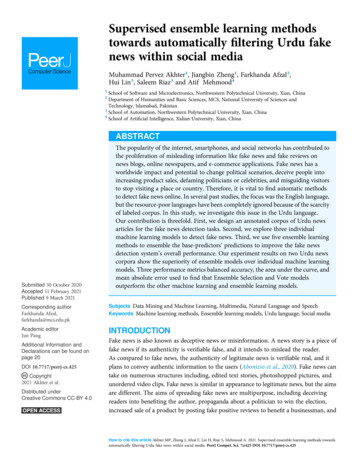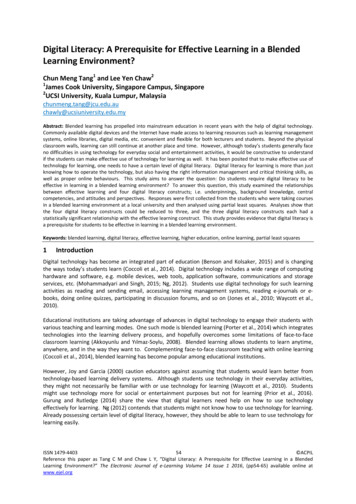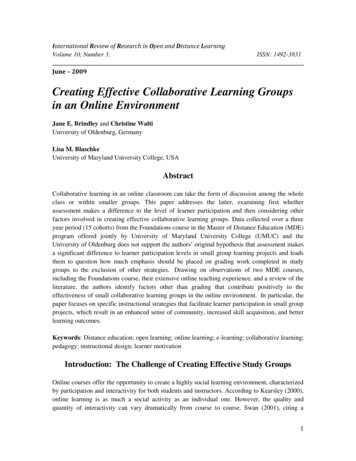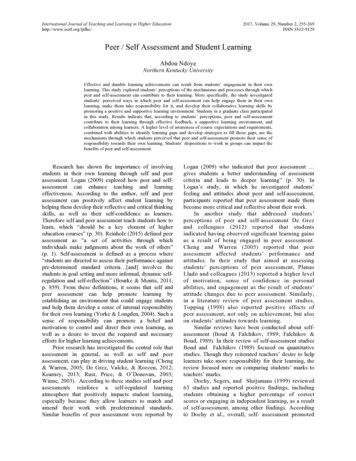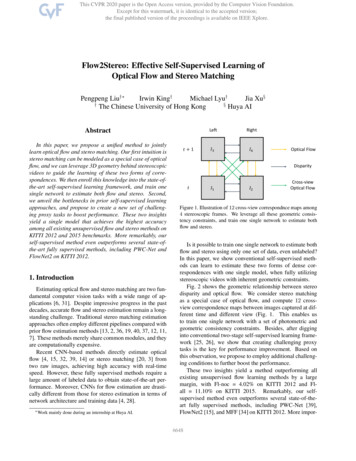
Transcription
Flow2Stereo: Effective Self-Supervised Learning ofOptical Flow and Stereo MatchingPengpeng Liu† Irwin King†Michael Lyu†Jia Xu§†§The Chinese University of Hong KongHuya AIAbstractIn this paper, we propose a unified method to jointlylearn optical flow and stereo matching. Our first intuition isstereo matching can be modeled as a special case of opticalflow, and we can leverage 3D geometry behind stereoscopicvideos to guide the learning of these two forms of correspondences. We then enroll this knowledge into the state-ofthe-art self-supervised learning framework, and train onesingle network to estimate both flow and stereo. Second,we unveil the bottlenecks in prior self-supervised learningapproaches, and propose to create a new set of challenging proxy tasks to boost performance. These two insightsyield a single model that achieves the highest accuracyamong all existing unsupervised flow and stereo methods onKITTI 2012 and 2015 benchmarks. More remarkably, ourself-supervised method even outperforms several state-ofthe-art fully supervised methods, including PWC-Net andFlowNet2 on KITTI 2012.1. IntroductionEstimating optical flow and stereo matching are two fundamental computer vision tasks with a wide range of applications [6, 31]. Despite impressive progress in the pastdecades, accurate flow and stereo estimation remain a longstanding challenge. Traditional stereo matching estimationapproaches often employ different pipelines compared withprior flow estimation methods [13, 2, 36, 19, 40, 37, 12, 11,7]. These methods merely share common modules, and theyare computationally expensive.Recent CNN-based methods directly estimate opticalflow [4, 15, 32, 39, 14] or stereo matching [20, 3] fromtwo raw images, achieving high accuracy with real-timespeed. However, these fully supervised methods require alarge amount of labeled data to obtain state-of-the-art performance. Moreover, CNNs for flow estimation are drastically different from those for stereo estimation in terms ofnetwork architecture and training data [4, 28]. Workmainly done during an internship at Huya AI.𝑡 1LeftRight𝐼3𝐼4Optical FlowDisparity𝑡𝐼1𝐼2Cross-viewOptical FlowFigure 1. Illustration of 12 cross-view correspondnce maps among4 stereoscopic frames. We leverage all these geometric consistency constraints, and train one single network to estimate bothflow and stereo.Is it possible to train one single network to estimate bothflow and stereo using only one set of data, even unlabeled?In this paper, we show conventional self-supervised methods can learn to estimate these two forms of dense correspondences with one single model, when fully utilizingstereoscopic videos with inherent geometric constraints.Fig. 2 shows the geometric relationship between stereodisparity and optical flow. We consider stereo matchingas a special case of optical flow, and compute 12 crossview correspondence maps between images captured at different time and different view (Fig. 1. This enables usto train one single network with a set of photometric andgeometric consistency constraints. Besides, after digginginto conventional two-stage self-supervised learning framework [25, 26], we show that creating challenging proxytasks is the key for performance improvement. Based onthis observation, we propose to employ additional challenging conditions to further boost the performance.These two insights yield a method outperforming allexisting unsupervised flow learning methods by a largemargin, with Fl-noc 4.02% on KITTI 2012 and Flall 11.10% on KITTI 2015. Remarkably, our selfsupervised method even outperforms several state-of-theart fully supervised methods, including PWC-Net [39],FlowNet2 [15], and MFF [34] on KITTI 2012. More impor16648
tantly, when we directly estimate stereo matching with ouroptical flow model, it also achieves state-of-the-art unsupervised stereo matching performance. This further demonstrates the strong generalization capability of our approach.𝑃𝑡𝑧 𝑃𝑃𝑡 12. Related WorkOptical flow and stereo matching have been widely studied in the past decades [13, 2, 36, 38, 45, 48, 49, 29, 21, 11].Here, we briefly review recent deep learning based methods.Supervised Flow Methods. FlowNet [4] is the first endto-end optical learning method, which takes two raw images as input and output a dense flow map. The followupFlowNet 2.0 [15] stacks several basic FlowNet models andrefines the flow iteratively, which significantly improves accuracy. SpyNet [32], PWC-Net [39] and LiteFlowNet [14]propose to warp CNN features instead of image at different scales and introduce cost volume construction, achieving state-of-the-art performance with a compact model size.However, these supervised methods rely on pre-training onsynthetic datasets due to lacking of real-world ground truthoptical flow. The very recent SelFlow [26] employs selfsupervised pre-training with real-world unlabeled data before fine-tuning, reducing the reliance of synthetic datasets.In this paper, we propose an unsupervised method, andachieve comparable performance with supervised learningmethods without using any labeled data.Unsupervised & Self-Supervised Flow Methods. Labeling optical flow for real-world images is a challenging task,and recent studies turn to formulate optical flow estimationas an unsupervised learning problem based on the brightness constancy and spatial smoothness assumption [17, 35].[30, 44, 16] propose to detect occlusion and exclude occluded pixels when computing photometric loss. Despitepromising progress, they still lack the ability to learn optical flow of occluded pixels.Our work is most similar to DDFlow [25] and SelFlow [26], which employ a two-stage self-supervision strategy to cope with optical flow of occluded pixels. In thispaper, we extend the scope to utilize geometric constraintsin stereoscopic videos and jointly learn optical flow andstereo disparity. This turns out to be very effective, as ourmethod significantly improves the quality of flow prediction in the first stage. Recent works also propose to jointlylearn flow and depth from monocular videos [52, 53, 47,33, 24] or jointly learn flow and disparity from stereoscopicvideos [22, 43]. Unlike these methods, we make full useof geometric constraints between optical flow and stereomatching in a self-supervised learning manner, and achievemuch better performance.Unsupervised & Self-Supervised Stereo Methods. Ourmethod is also related to a large body of unsupervised stereolearning methods, including image synthesis and warping𝐩𝑙𝑡𝑓𝑂𝑙𝑦𝐩𝑙𝑡 1𝐩𝑟𝑡 e 2. 3D geometric constraints between optical flow (wl andwr ) and stereo disparity from time t to t 1 in the 3D projectionview.with depth estimation [5], left-right consistency [8, 51, 9],employing additional semantic information et al. [46], cooperative learning [23], self-adaptive fine-tuning et al. [41,50, 42]. Different from all these methods that design a specific network for stereo estimation, we train one single unified network to estimate both flow and stereo.3. Geometric Relationship of Flow and StereoIn this section, we review the geometric relationship between optical flow and stereo disparity from both the 3Dprojection view [10] and the motion view.3.1. Geometric Relationship in 3D ProjectionFig. 2 illustrates the geometric relationship betweenstereo disparity and optical flow from a 3D projection view.Ol and Or are rectified left and right camera centers, B isthe baseline distance between two camera centers.Suppose P (X, Y, Z) is a 3D point at time t, and it movesto P P at time t 1, resulting in the displacement as P ( X, Y, Z). Denote f as the focal length, p (x, y) as the projection point of P on the image plane, then)(x, y) fs (X,YZ , where s is the scale factor that convertsthe world space to the pixel space, i.e., how many metersper pixel. For simplicity, let f ′ fs , we have (x, y) )f ′ (X,YZ . Take the time derivative, we obtain( x, y)1 ( X, Y )(X, Y ) Z f′ f′ tZ tZ 2 t(1)Let w (u, v) be the optical flow vector (u denotes motionin the x direction and v denotes motion in the y direction)and the time step is one unit (from t to t 1), then Eq. (1)26649
Photometric 2𝐼ሚ3𝐼ሚ4𝐼ሚ1TeacherModel𝑀𝑖 𝑗𝐰𝑗 𝑖𝑀𝑗 𝑖 𝑖 𝑗𝐰StudentModel𝐼ሚ2𝐰𝑖 𝑗QuadrilateralConstraint LossTriangleConstraint LossSelf-SupervisionLossStage 1Stage 2 𝑗 𝑖𝐰Figure 3. Our self-supervised learning framework contains two stages: In stage 1, we add geometric constraints between optical flow andstereo disparity to improve the quality of confident predictions; In stage 2, we create challenging proxy tasks to guide the student modelfor effective self-supervised learning.becomes,(u, v) f ′ Z( X, Y ) f ′ 2 (X, Y )ZZ(2)For calibrated stereo cameras, we let P in the coordinatesystem of Ol . Then Pl P (X, Y, Z) in the coordinatesystem of Ol and Pr (X B, Y, Z) in the coordinatesystem of Or . With Eq. (2), we obtain,() f ′ Z(ul , vl ) f ′ ( X, YZZ 2 (X, Y ), (3)′ Z′ ( X, Y ) f(ur , vr ) fZZ 2 (X B, Y )This can be further simplified as,(ur ul f ′ B ZZ2 ,vr vl 0(4)Suppose d is the stereo disparity (d 0), according to thedepth Z and the distance between two camera centers B,we have d f ′ BZ . Take the time derivative, we have dB Z f ′ 2 tZ t(5)Similarly, we set time step to be one unit, thendt 1 dt f ′ B ZZ2With Eq. (4) and (6), we finally obtain,(ur ul ( dt 1 ) ( dt ).vr vl 0(6)(7)Eq. (7) demonstrates the 3D geometric relationship between optical flow and stereo disparity, i.e., the differencebetween optical flow from left and right view is equal to thedifference between disparity from time t to t 1. Note thatEq. (7) also works when cameras move, including rotatingand translating from t to t 1. Eq. (7) assumes the focallength is fixed, which is common for stereo cameras.Next, we review the geometric relationship between flowand stereo in the motion view.3.2. Geometric Relationship in MotionOptical flow estimation and stereo matching can beviewed as one single problem: correspondence matching.Optical flow describes the pixel motion between two adjacent frames recorded at different time, while stereo disparity represents the pixel displacement between two stereoimages recorded at the same time. According to stereo geometry, the correspondence pixel shall lie on the epipolarline between stereo images. However, optical flow does nothave such a constraint, this is because both camera and object can move at different times.To this end, we consider stereo matching as a specialcase of optical flow. That is, the displacement betweenstereo images can be seen as a one dimensional movement.For rectified stereo image pairs, the epipolar line is horizontal and stereo matching becomes finding the correspondence pixel along the horizontal direction x.In the following, we consider stereo disparity as a formof motion between stereo image pairs. For simplicity, letI1 , I3 denote the left-view images at time t and t 1, I2 , I4denote the right-view images at time t and t 1 respectively.Then we let w1 3 denote the optical flow from I1 to I3 ,w1 2 denote the stereo disparity from I1 to I2 . For stereodisparity, we only keep the horizontal direction of opticalflow. For optical flow and disparity of other directions, wedenote them in the same way.Apart from optical flow in the left and right view, disparity at time t and t 1, we also compute the cross-view optical flow between images captured at different time and different view, such as w1 4 (green row in Fig. 1). In this case,36650
ItIt 1Fl: 31.39%Fl: 14.38%Fl: 15.19%Fl: 8.31%Fl: 27.14%Fl: 15.07%Fl: 16.40%Fl: 9.59%ItIt 1(a) Input Images(b) MFO-Flow [16](c) DDFlow [25](d) SelFlow [26](e) OursFigure 4. Qualitative evaluation on KITTI 2015 optical flow benchmark. For each case, the top row is optical flow and the bottom row iserror map. Our model achieves much better results both quantitatively and qualitatively (e.g., shaded boundary regions). Lower Fl is better.we compute the correspondence between every two images,resulting in 12 optical flow maps as shown in Fig. 1. We employ the same model to compute optical flow between everytwo images.Suppose plt is a pixel in I1 , prt , plt 1 , prt 1 are its correspondence pixels in I2 , I3 and I4 respectively, then wehave, rll pt pt w1 2 (pt )ll(8)pt 1 pt w1 3 (plt ) . rllpt 1 pt w1 4 (pt )A pixel directly moves from I1 to I4 shall be identical to themovement from I1 to I2 and from I2 to I4 . That is,w1 4 (plt ) (prt 1 prt ) (prt plt )w2 4 (prt ) w1 2 (plt ).(9)Similarly, if the pixel moves from I1 to I3 and from I3 toI4 , thenw1 4 (plt ) (prt 1 plt 1 ) (plt 1 plt ) w3 4 (plt 1 ) w1 3 (plt ).(10)From Eq. (9) and (10), we obtain,w2 4 (prt ) w1 3 (plt ) w3 4 (plt 1 ) w1 2 (plt ). (11)For stereo matching, the correspondence pixel shall lie onthe epipolar lines. Here, we only consider rectified stereocases, where epipolar lines are horizontal. Then, Eq.(11)becomes(u2 4 (prt ) u1 3 (plt ) u3 4 (plt 1 ) u1 2 (plt ).v2 4 (prt ) v1 3 (plt ) 0(12)Note Eq. (12) is exactly the same as Eq. (7).In addition, since epipolar lines are horizontal, we canre-write Eq. (9) and (10) as follows: u1 4 (plt ) u2 4 (prt ) u1 2 (plt )v1 4 (plt ) v2 4 (prt ).u1 4 (plt ) u3 4 (plt 1 ) u1 3 (plt )v1 4 (plt ) v1 3 (plt )(13)This leads to the two forms of geometric constraints weused in our training loss functions: quadrilateral constraint(12) and triangle constraint (13).4. MethodIn this section, we first dig into the bottlenecks of thestate-of-the-art two-stage self-supervised learning framework [25, 26]. Then we describe an enhanced proxy learning approach, which can improve its performance greatly inboth two stages.4.1. Two-Stage Self-Supervised Learning SchemeBoth DDFlow [25] and SelFlow [26] employ a twostage learning approaches to learning optical flow in a selfsupervised manner. In the first stage,
self-supervised method even outperforms several state-of-the-art fully supervised methods, including PWC-Net and FlowNet2 on KITTI 2012. 1. Introduction amental computer vision tasks with a wide range of ap-plications [6, 31]. Despite impressive progress in the past
